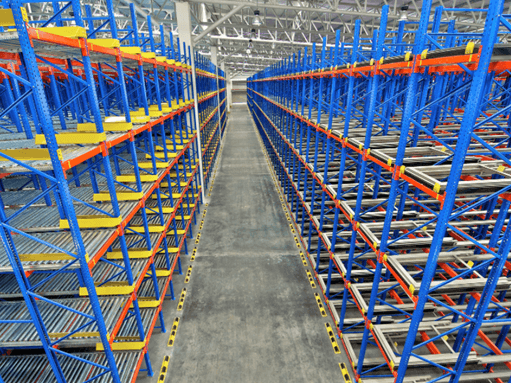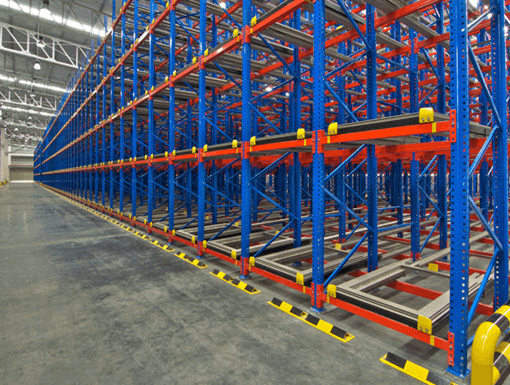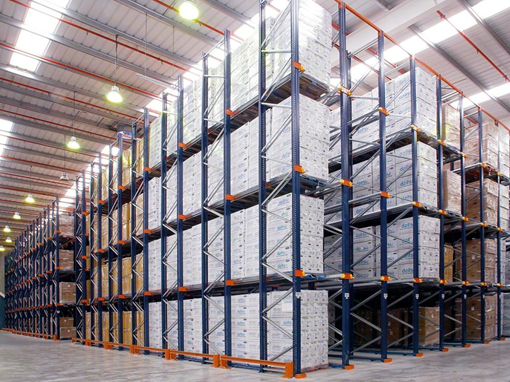There are many different types of pallet racking systems on the market, and it can be challenging to decide which type is best for your warehouse. In this blog post, we will break down the different kinds of pallet racking systems and discuss the benefits and drawbacks of each one.
Let’s explore each kind and the advantages and disadvantages of each so you can choose the right pallet racking system for your business.
What is a Pallet Racking System?
A pallet racking system is a storage system that stores pallets of items in horizontal rows on multiple levels, allowing for better storage density by taking advantage of available vertical space.
Pallets are loaded onto the racks and unloaded into the rack typically by a forklift truck.
Types of Racking Systems
- Selective Pallet Racking
- Double Deep Pallet Rack
- Carton Flow Pallet Racking
- Cantilever Pallet Rack
- Multi-Tier Pallet Rack
- Drive-In Pallet Racking
- Pallet Flow Rack
- Push Back Pallet Rack
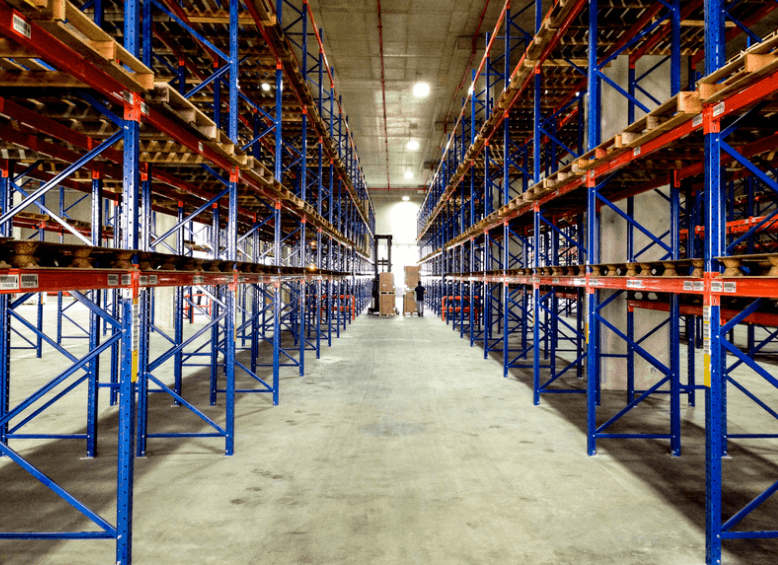
Selective Pallet Racking: The Most Popular Racking Solution for Warehouse Storage Needs
The selective pallet rack, also known as static racking is the most popular pallet storage system among warehouses. Its popularity is due to its low cost and wide selection of upright heights and beam sizes for custom configuration.
It allows you to store loads at various heights, and it allows for access to 100% of the loads. Because you have direct access to each load, you have 100% “selectivity.”
Selective pallet racks have been around since the 1950s, but they continue to be popular because of their relatively low cost and many benefits.
Advantages of Selective Pallet Racking
- Easy assembly and de-install
- It can be configured in different ways for your industrial equipment
- Lower entry price compared to more complex racking systems
Disadvantages of Selective Pallet Racking
- Lower storage density compared to other types of racking
- Less efficient use of floor space due to many aisles
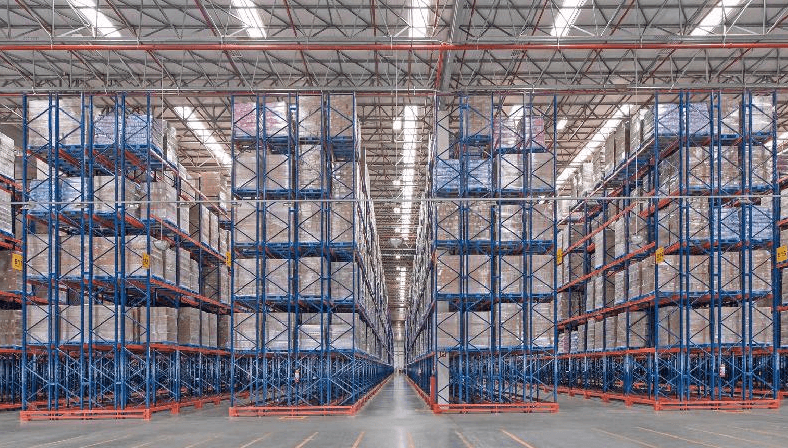
Double Deep Pallet Rack: Increase your Storage Space
Double deep warehouse racking systems share the same components as a selective racking system, except for one thing: the two rows of rack are installed adjacent to one another, which means a higher storage density is possible.
However, since they are two loads deep you will need a double deep reach truck with an extendable pantograph to load and unload from these pallet rack systems.
Advantages of Double Deep Pallet Rack
- Easy assembly and de-install
- Greater storage density than selective pallet rack systems
- It can be configured in different ways for your industrial equipment
- Lower entry price compared to more complex racking systems
Disadvantages of Double Deep Pallet Rack
- Reduction in selectivity to 50%
- Requires either a bottom beam level or longer beams to accommodate the outriggers of the double deep reach truck
- Requires more expensive loading and unloading equipment
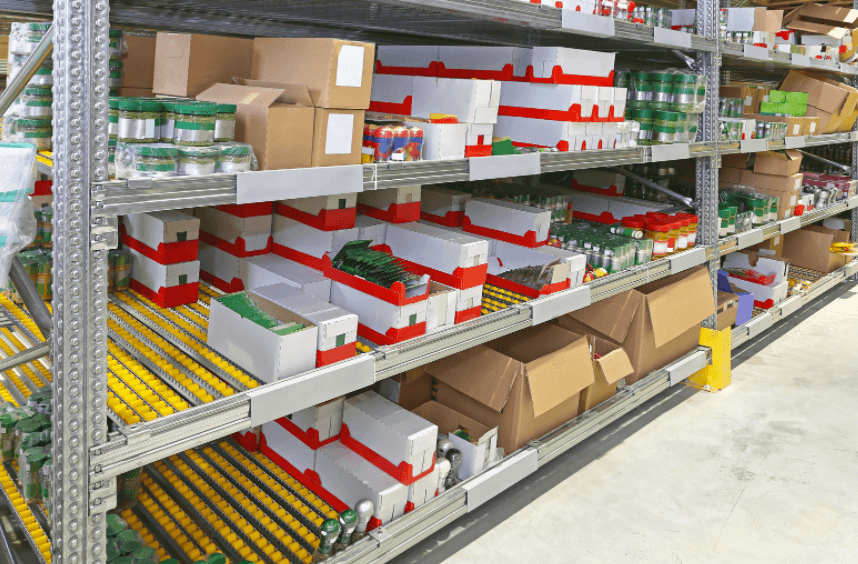
Carton Flow Pallet Racks: The Ideal Storage Solution for Businesses With High Turnover Rates
If your business has high turnover rates for its products, you may want to consider using a carton flow rack system.
Carton flow racks are designed specifically for businesses that deal with small non-palletized, lightweight items and need to pick orders frequently and quickly.
It typically uses uprights and beams like a selective rack system; however, the lower levels are equipped with rollers mounted to rails to transport the cartons from the loading side to the picking side of the system, allowing workers at a ground level easy access when loading or unloading cartons.
It is common to have pallets stored above the carton flow rack.
Advantages of Carton Flow Rack Systems
- Fit for a combination of different carton sizes
- Uses gravity as a free power source
- Clear visibility of product inventory
- Enhanced efficiency for order fulfillment
Disadvantages of Carton Flow Rack Systems
- Carton flow racks are more expensive than standard pallet racking systems
- Typically requires manual unloading of pallets to load cartons into the system
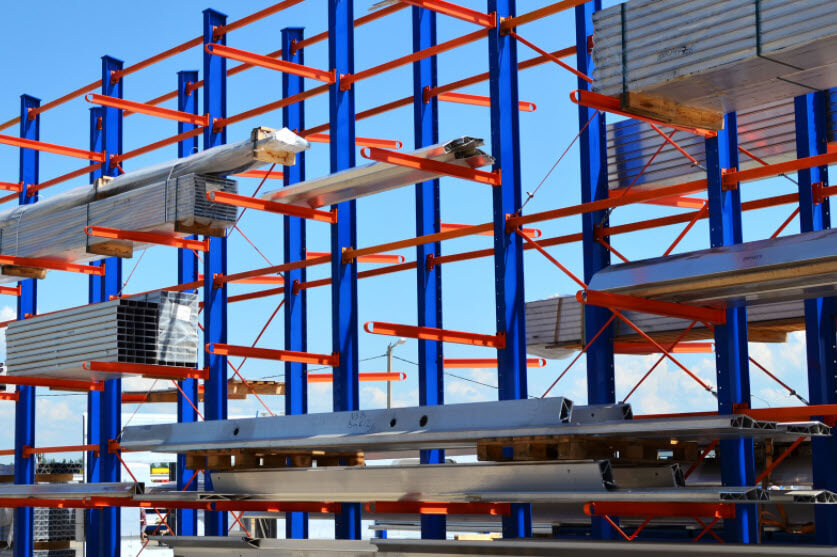
Cantilever Racking System: Perfect for Long Loads
Cantilever racking systems utilize arms attached to upright posts to store long items such as pipes, carpet rolls, and lumber.
Built out of a combination of towers, arms, and bases, cantilever racks are ideal for storing long loads.
They employ vertical supports on the rear side of their structure and use arms that extend from the back to support loads with no vertical obstruction on the loading side of the system.
Advantages of Cantilever Racks
- Ideal for long loads
- Easy to install and reconfigure
- A broad number of capacity ranges
- No vertical obstruction on the front of the system, allowing the ability to stack materials horizontally
Disadvantages of Cantilever Racks
- Can require additional flooring or reinforcement
- Requires very wide aisle for material handling equipment access
- Cannot store pallets
- Load must be self-supporting
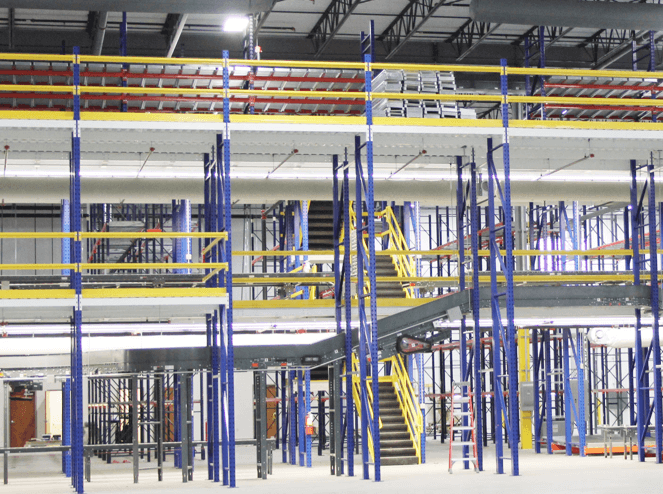
Multi-Tier Pallet Rack: Leverage Vertical Height
Multi-tier racking (also referred to as a pick module structure) offers an enhanced use of vertical space. They have different levels for manual picking and loading that are connected by stairs.
These systems are great for orders with small items, such as auto parts and fastener distributors and pharmaceutical companies.
Thanks to the multiple levels, multi-tiered pallet racks create higher density picking. Some means of conveying equipment are typically required to transport the picked goods out of the system.
Advantages of Multi-Tier Pallet Racking
- Maximum use of vertical warehouse space for order picking
- Flexible for different cartons or item sizes
- Direct access to SKUs without the use of industrial equipment
- Safe and enclosed to protect workers
Disadvantages of Multi-Tier Pallet Racking
- Relative expense

Drive-In Pallet Racks: Ideal For Businesses With Limited Warehouse Space
Drive-in pallet rack is popular in warehouses because it allows businesses to store many goods in a small area for very dense storage. It’s perfect for warehouses with limited warehouse space since it eliminates aisles by having one shared entry and exit point.
The operator “drives-in,” to the system, and loads and unloads from one side of the system.
Because the operator drives into the system, there is greater interaction between the rack and the forklift resulting in an increased risk of damage and safety concerns.
Advantages of Drive-In Pallet Racks
- By removing aisles you increase storage space
Disadvantages of Drive-In Pallet Racks
- Utilizes LIFO (last-in-first-out storage) so older inventory can get stuck in the back of the racking system
- Low selectivity that may require multiple handling
- Since forklifts place and retrieve items within the racks, there is more risk of damage
- Pallet sizes must be the same size to fit in the lanes
- Pallet condition is very important as it provides the support of the load
- Risk of “honeycombing” with undisciplined storage put-away
- Challenging inventory management
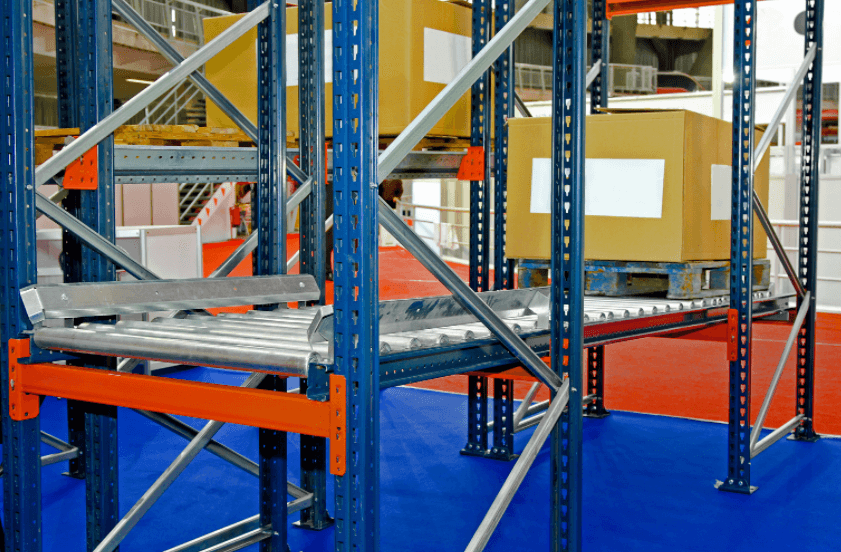
Pallet Flow Racks: Take Advantage of Gravity
Pallet Flow Rack systems utilize common selective pallet rack components, with the addition of roller tracks.
One side of the pallet flow rack (also called gravity flow racks) is for loading, and the other end is for picking. Pallets are loaded into the back of the system and they roll to the front of the system by means of gravity rollers.
This gravity system increases storage capacity and enhances the storage and retrieval process, which reduces the workforce and labor required.
They are commonly seen in applications that have products with expiration dates due to the higher turnover rates these FIFO (first-in-first-out) pallet rack systems provide.
Advantages of Pallet Flow Racks
- It uses the FIFO method, preventing inventory from getting stuck in the back
- Quick and efficient inventory turnover
- Very high storage density with little lost space
- Reduces replenishment for picking (great for fast-moving SKUs)
Disadvantages of Pallet Flow Racks
- Pallets can become jammed if broken pieces get caught in the gravity rollers
- Reliant on pallets as the medium for movement
- Require maintenance on wheels and brakes
- One of the most expensive pallet racking systems
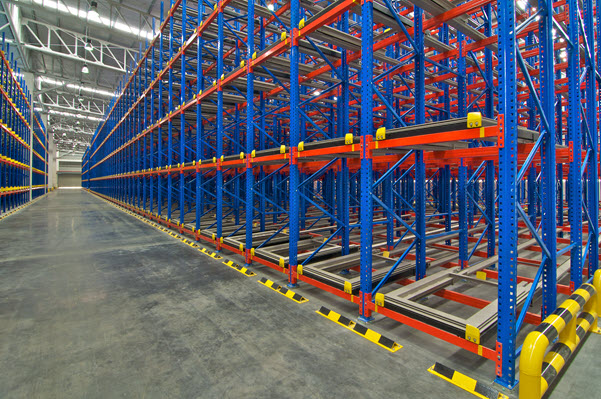
Push Back Pallet Racking: Ideal for Storage Density
Push-back pallet rack systems are perfect for warehouses that have a high volume of SKUs and that are looking for storage density.
The racks use pallets that are stored on inclined rails with free-rolling carts. As pallets are loaded into the system, the loading pallet pushes or stores pallets toward the back of the system, with the new pallet assuming the storage location of the old. When loads are removed from the front of the rack, the next pallet rolls to the front position.
This type of rack is ideal for storing frequently accessed products since items utilize gravity to move the next group of materials forward.
Since everything can be accessed from the front of the aisle, push-back racks use the LIFO method and require fewer pick aisles.
Advantages of Push Back Pallet Racking
- High-density storage
- Custom designed for your pallet sizes
- Decreased labor costs
- Forklifts do not enter the rack structure, limiting damage
- Increased Pallet Access
Disadvantages of Push-Back Pallet Racking
- Limited to 5 or 6 pallets deep
- Reliance on the load to push the other loads
- Possible product damage when carts slide forward
- Loss of some vertical space due to the slope of the rails
- Higher costs and more frequent maintenance – due to the number of wheels, carts, and bearings used
Other Types of Dynamic Racking
Many other types of dynamic racking can be customized to fit the needs of your warehouse.
These include pallet flow racks, light shelving, and mezzanine structures.
Conclusion
Warehouse pallet racking systems come in many forms and choosing the right solution for your facility’s needs can be challenging.
An excellent place to start is identifying the number of palletized SKUs, the dimensions of your pallets, the variety of pallet sizes, and determining the weight of your pallets.
More detailed steps will include discovering how long SKUs will be in your facility, the relationship between storage density and product movement, what form of retrieval is best, and the placement of your industrial racking.
If you are considering storage systems and need the assistance of an innovative warehouse storage team, we would be thrilled to help. To get help today, please visit our contact us page.
FAQ
How often should warehouse racking be inspected?
acks that are more susceptible to damage should be inspected every three months. Racks with a low risk of damage should be inspected every six months.
How do you inspect warehouse racking?
1. Look for dents, twists, or deep scrapes along the beams and uprights
2. Check deflection levels
3. Check that your load beams are seated into your uprights
4. Look for any broken welds
How to clean warehouse racking?
Warehouse racking should be cleaned on a regular basis to ensure that pallets are not damaged and products are correctly stored. The best way to clean your warehouse rack is by using an air compressor. An air compressor will remove any dust, dirt, or debris from the pallet load without damaging the pallets or pallet loads. Afterward, vacuum the floor to remove obstructions from the walkways.
How do you maintain warehouse racking?
• Inspect your warehouse racking at least once a year for signs of damage, wear and tear, corrosion, or rust. If you find any problems with your racks, contact a professional immediately so they can repair them before more damage occurs.
• Make sure all pallets have labels on them so you can quickly identify the contents and where they should be stored
• Keep pallets away from walls to prevent damage
– Do not overload racks with pallets or products
• Use an air compressor to clean warehouse racks regularly. This will remove any dust, dirt, or debris accumulated on the pallet load

